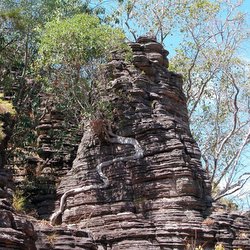
Rock formation in northern Australia. Image credit: Jochen J. Brocks. Click to enlarge.
NASA exobiology researchers confirmed Earth’s oceans were once rich in sulfides that would prevent advanced life forms, such as fish and mammals, from thriving. The research was funded in part by NASA’s exobiology program.
A team of scientists from the Massachusetts Institute of Technology and Harvard University, working with colleagues from Australia and the United Kingdom, analyzed the fossilized remains of photosynthetic pigments preserved in 1.6 billion-year-old rocks from the McArthur Basin in Northern Australia.
They found evidence of photosynthetic bacteria that require sulfides and sunlight to live. Known as purple and green sulfur bacteria because of their respective pigment colorations, these single-celled microbes can only live in environments where they simultaneously have access to sulfides and sunlight.
The researchers also found very low amounts of the fossilized remains of algae and oxygen-producing cyanobacteria. The relative scarcity of these organisms is due to poisoning by large amounts of sulfide.
“This work suggests Earth’s oceans may have been hostile to animal and plant life until relatively recently,” said Dr. Carl Pilcher, NASA’s senior scientist for astrobiology. “If so, this would have profound implications for the evolution of modern life.”
“The discovery of the fossilized pigments of purple sulfur bacteria is totally new and unexpected. Because they need fairly high intensity sunlight, it means the pink bacteria, along with their essential source of sulfide, close to the surface, perhaps as close as 20 to 40 meters,” said Roger Summons, Massachusetts Institute of Technology professor of geobiology. “The sulfide would have come from bacteria that reduces sulfate carried into the oceans by the weathering of rocks.”
“The McArthur Basin rocks were deposited over a very large area and over many millions of years, so it’s likely they formed under water that was intermittently connected to or actually part of an ocean. In turn, this implies the ocean had an abundant and continuous supply of hydrogen sulfide and must have been quite toxic to any oxygen-breathing organisms,” said team member Jochen Brocks. “In fact, for seven-eighths of Earth’s 4.5 billion-year history, there was probably little oxygen in the oceans and certainly not enough to support oxygen-breathing marine animals.”
This research continued the efforts of NASA and partner institutions to understand the early history of the Earth. Research results were published in the Oct. 6, 2005, edition of Nature magazine.
The research was conducted by a team working in Summons’ laboratory. Team members include Jochen Brocks, formerly of Harvard and now at Australian National University; Gordon Love, Massachusetts Institute of Technology; Stephen Bowden, University of Aberdeen, Scotland; Graham Logan, Geoscience Australia; and Andrew Knoll, Harvard.
Original Source: NASA News Release

Hey, cool tips. Perhaps I’ll buy a glass of beer to the person from that chat who told me to go to your blog 🙂